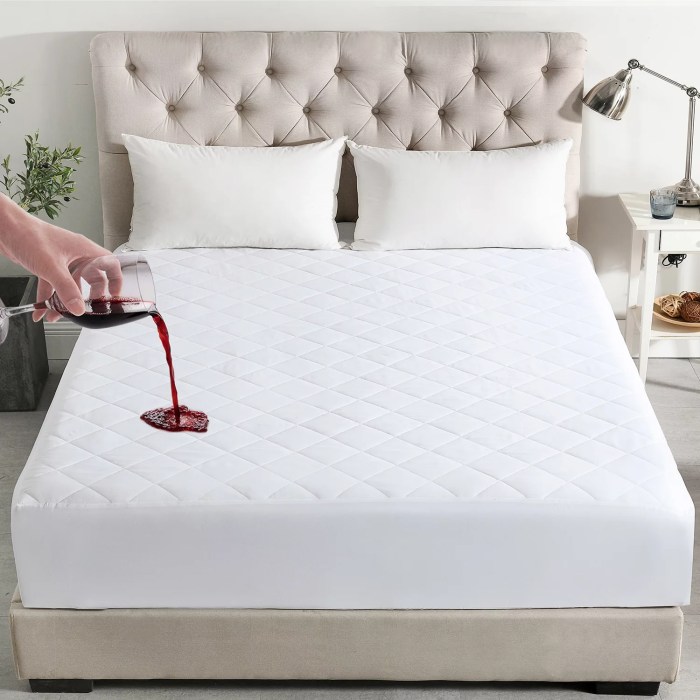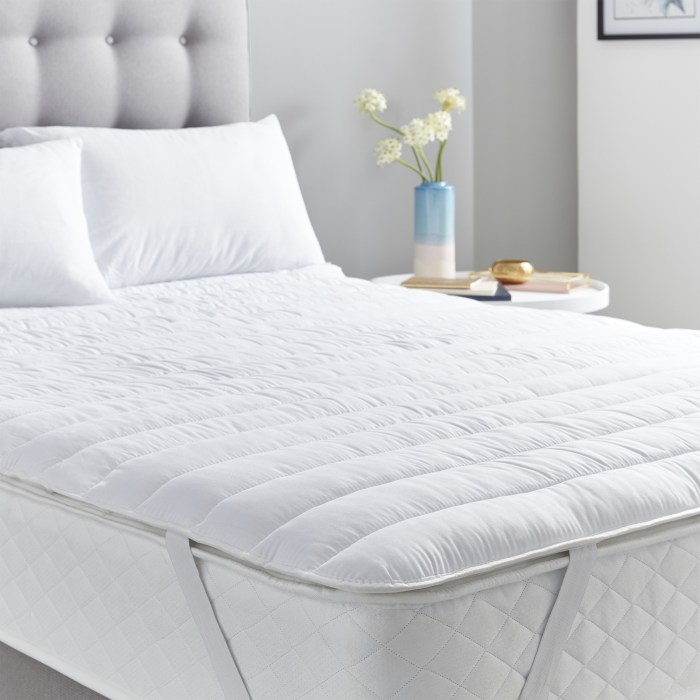Mattress protectors are essential for safeguarding your mattress from stains, spills, dust mites, and allergens, ensuring a clean and comfortable sleep experience. Made from various materials like cotton, bamboo, polyester, and vinyl, they provide breathability, temperature regulation, and protection tailored to your specific needs.
Discover the latest trends and innovations in mattress protector technology, including eco-friendly options and advanced designs. Customer reviews and testimonials offer valuable insights to guide your purchasing decisions and ensure you find the perfect protector for your mattress.
Product Overview
Mattress protectors are essential accessories designed to safeguard your mattress from spills, stains, dust mites, and other potential hazards. They provide a barrier between your mattress and the elements, ensuring a clean and hygienic sleeping environment.
Mattress protectors are an essential part of any bedding set, providing a barrier against dust, spills, and allergens. For those who value convenience and space-saving solutions, a foldable mattress is an excellent choice. These mattresses can be easily folded and stored, making them ideal for small spaces or occasional use.
However, it’s crucial to remember that even foldable mattresses benefit from the protection of a mattress protector, ensuring their longevity and hygiene.
Mattress protectors come in various types, each with its unique set of features and benefits. They can be made from a range of materials, including cotton, bamboo, polyester, and vinyl, each offering different levels of protection and comfort.
Materials Used in Mattress Protectors
- Cotton:Soft, breathable, and hypoallergenic, cotton protectors provide a comfortable and natural sleeping surface.
- Bamboo:Eco-friendly and moisture-wicking, bamboo protectors regulate temperature and keep you cool and dry throughout the night.
- Polyester:Durable and wrinkle-resistant, polyester protectors offer excellent protection against spills and stains.
li> Vinyl:Waterproof and hypoallergenic, vinyl protectors provide the ultimate barrier against liquids and allergens.
Protection and Functionality
Mattress protectors serve as a vital shield for your mattress, safeguarding it from a myriad of threats that can compromise its hygiene and comfort. They act as a barrier against stains, spills, dust mites, and allergens, ensuring that your sleep haven remains pristine and allergen-free.
Beyond protection, mattress protectors also play a crucial role in regulating temperature and breathability. Different materials offer varying levels of these properties, catering to specific needs and preferences. For instance, cotton protectors provide excellent breathability, allowing air to circulate freely and preventing overheating.
Conversely, waterproof protectors prioritize liquid protection, but may compromise breathability to some extent.
Choosing the Right Mattress Protector
Selecting the right mattress protector depends on your individual requirements. If allergy protection is paramount, consider protectors specifically designed to block dust mites and allergens. For those seeking enhanced comfort and temperature regulation, breathable protectors made from materials like cotton or bamboo may be ideal.
Waterproof protectors are indispensable for individuals prone to spills or accidents.
Care and Maintenance

Proper care and maintenance of mattress protectors are crucial to ensure their longevity and effectiveness. By following the recommended guidelines, you can keep your mattress protector in optimal condition and extend its lifespan.
Washing and Drying
Mattress protectors should be washed regularly to remove dirt, dust mites, and other allergens that accumulate over time. Use warm water and a mild detergent specifically designed for delicate fabrics. Avoid using bleach or fabric softeners, as they can damage the material.
Tumble dry on low heat or air dry to prevent shrinkage.
Stains and Spills
Accidents happen, and spills on your mattress protector are inevitable. Act promptly to prevent stains from setting. Blot up any excess liquid with a clean cloth or paper towels. For fresh stains, use a mixture of equal parts water and white vinegar.
Apply the solution to the stain and allow it to sit for a few minutes before blotting. For older or stubborn stains, consult the manufacturer’s instructions or seek professional cleaning services.
Mattress protectors are an essential component for maintaining the longevity of your mattress. They provide a protective layer against spills, dust mites, and other allergens. For an extra layer of comfort, consider adding a mattress topper . Mattress toppers can enhance the firmness or softness of your mattress, providing customized support and pressure relief.
By combining a mattress protector with a mattress topper, you can create a comfortable and hygienic sleep environment that will extend the life of your mattress.
Storage, Mattress protector
When not in use, store your mattress protector in a cool, dry place. Avoid folding or creasing it, as this can weaken the material. If possible, store it in its original packaging or a breathable storage bag.
Tips for Extending Lifespan
* Use a mattress protector that fits snugly to prevent excessive movement and wear.
- Wash the mattress protector regularly, but avoid overwashing.
- Inspect the mattress protector periodically for any signs of damage or wear.
- Replace the mattress protector every 2-3 years, or more often if necessary.
Industry Trends and Innovations

The mattress protector industry is constantly evolving to meet the changing needs of consumers. Recent years have seen a surge in demand for eco-friendly and sustainable products, as well as for protectors that offer enhanced comfort and protection.
Some of the latest trends in the mattress protector industry include:
New Materials
- Bamboo fibers are becoming increasingly popular due to their natural antibacterial and hypoallergenic properties.
- Organic cotton is another sustainable option that is soft, breathable, and durable.
- Memory foam is a popular choice for mattress protectors that offer added comfort and support.
New Technologies
- Waterproof membranes are essential for protecting mattresses from spills and stains. New technologies have made these membranes thinner and more breathable, while still providing excellent protection.
- Anti-allergen treatments can help to reduce allergies and asthma symptoms by blocking dust mites and other allergens.
- Cooling technologies can help to keep you cool and comfortable while you sleep.
Environmental Sustainability
- Mattress protectors made from recycled materials are a more sustainable option than those made from virgin materials.
- Protectors that are biodegradable or compostable can help to reduce waste.
- Look for mattress protectors that are certified by independent organizations, such as OEKO-TEX, to ensure that they are free of harmful chemicals.
Customer Reviews and Testimonials

Customer reviews and testimonials provide valuable insights into the real-world performance of mattress protectors. By reading these firsthand accounts, consumers can gain a better understanding of the pros and cons of different products and make informed purchasing decisions.
A mattress protector is a crucial investment to safeguard your precious mattress, extending its lifespan and maintaining its pristine condition. For outdoor adventures, a camping mattress offers a comfortable sleeping surface while protecting against moisture, dirt, and insects. Similarly, a mattress protector shields your indoor mattress from spills, dust mites, and wear and tear, ensuring a restful and hygienic sleep experience.
When evaluating customer feedback, it is important to consider both positive and negative reviews. Positive reviews can highlight the benefits of a particular mattress protector, such as its comfort, breathability, or stain resistance. Negative reviews, on the other hand, can reveal potential drawbacks, such as poor fit, durability issues, or unpleasant odors.
Pros and Cons of Various Mattress Protectors
- Waterproof protectors:Pros – excellent protection against spills and accidents; Cons – may be less breathable, can feel noisy.
- Allergy-resistant protectors:Pros – effective in blocking allergens like dust mites and pet dander; Cons – may be less breathable, can be expensive.
- Breathable protectors:Pros – allow air to circulate, reducing heat buildup; Cons – may offer less protection against spills or stains.
- Cooling protectors:Pros – help regulate body temperature, reducing sweating; Cons – may be less effective in colder climates.
- Fitted protectors:Pros – secure fit, preventing shifting; Cons – may be difficult to remove or adjust.
- Zippered protectors:Pros – easy to remove and wash; Cons – zipper may snag or break.
Ultimate Conclusion
Investing in a mattress protector is an investment in a good night’s sleep. Protect your mattress, enhance your comfort, and enjoy peace of mind knowing that your bed is clean and allergen-free. With the right mattress protector, you can wake up refreshed and rejuvenated every morning.
Top FAQs: Mattress Protector
How often should I wash my mattress protector?
Every 2-3 months or more frequently if you have allergies or pets.
Can I put my mattress protector in the dryer?
Yes, but use a low heat setting and avoid over-drying to prevent shrinkage.
What is the best type of mattress protector for allergies?
Allergy-proof mattress protectors made with hypoallergenic materials like bamboo or cotton.